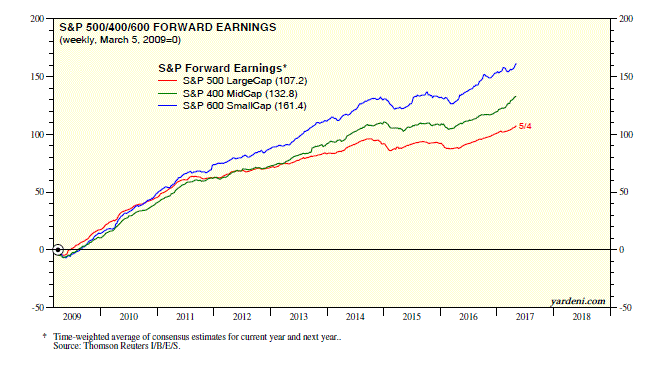
The money keeps pouring into equity ETFs. The latest data from the Investment Company Institute shows that they attracted $38.1 billion during March, $98.6 billion during Q1, and $198.7 billion since November, when Donald Trump was elected president. Over the past 12 months through March, equity ETFs attracted a record $295 billion. No wonder the S&P 500 is up 7.1% YTD through Tuesday’s close and is just 0.1% below Monday’s record high. It is up 12.0% since Election Day.
Just as impressive, the S&P Midcap 400 and S&P 600 SmallCaps stock price indexes are up 14.2% and 16.7% since Election Day. The stock market rally since then has been attributable to a combination of higher forward P/Es and increases to record highs in the forward earnings of the S&P 500/400/600. The current bull market has been especially good for MidCap and SmallCap investors. Consider the following:
(1) Performance and earnings derby. The S&P 500/400/600 price indexes are up 254.7%, 329.7%, and 368.3% since March 9, 2009. That’s because the forward earnings of the three composites are up 107.2%, 132.8%, and 161.4% over that same period.
(2) Valuation derbies. All three started the bull market with forward P/Es just above 10.0, specifically at 10.3, 10.1, and 11.1, respectively. These valuation multiples for the S&P 500/400/600 are currently 17.5, 18.3, and 19.4.
(3) Earnings in 2017 and 2018. Analysts’ consensus expectations in early May showed earnings growth for the S&P 500/400/600 of 11.4%, 10.5%, and 9.8% this year. Next year, they expect estimate growth rates will be 11.9%, 13.6%, and 19.8%. Interestingly, their expectations for 2018 have been remarkably stable since late last year for the LargeCaps and SmallCaps, while their MidCap consensus forecast has been rising.
(4) Q1 upside hooks. Now that the Q1 earnings season is almost complete, we see upside hooks in the results relative to expectations at the start of the season for all three composites. The S&P 500/400/600 Q1 actual/blended numbers now show y/y gains of 13.9%, 10.5%, and 6.3%. In other words, LargeCap investors have something to brag about for now. (By the way, at the beginning of the current earnings season, the estimates were 9.2%, 6.7%, and 2.1%.)
(5) Alpha and beta. The reason that small companies grow faster than large companies is that if they survive, they tend to grow into bigger companies, while the large ones may have hit their critical mass many years ago. There is more alpha in small companies, and more beta in large companies. “Alpha” refers to company-specific developments, while “beta” refers to economy-wide ones that impact all companies. Of course, this can be a curse during recessions when both alpha and beta fall apart for many small companies, while large companies mostly take a beta hit.
Currently, the big problem for all companies is a shortage of workers. This hits smaller companies harder because they need to increase their payrolls to grow more so than large ones. The NFIB survey of small business owners released Tuesday for April showed that 31.7% are not able to fill open positions, using the three-month average to reduce m/m volatility in this series. That’s the highest since February 2001. On the other hand, 17.5% of them are saying that government regulation is their number-one problem, down from a recent peak of 22.2% during May 2015. SmallCaps and MidCaps are likely to benefit more than LargeCaps from President Trump’s economic agenda to reduce regulations and cut corporate taxes.

